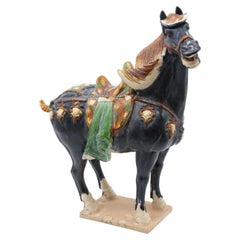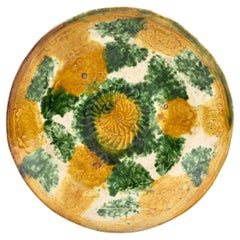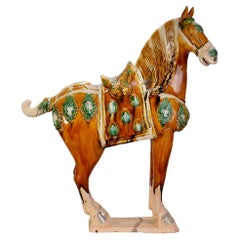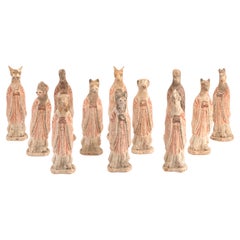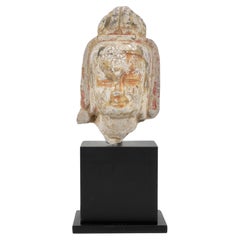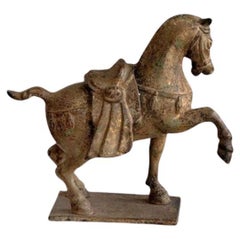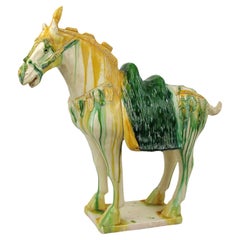Tang Furniture
14
156
2
to
26
114
14
158
158
158
192,754
116,605
41,824
32,232
15,102
11,558
10,385
10,235
9,439
8,672
7,259
7,110
6,240
5,877
5,597
5,191
4,632
3,536
101
9
46
2
6
13
10
1
2
1
109
49
41
18
17
146
144
135
7
2
3
Style: Tang
Large Chinese Ceramic Tang Horse
Located in Troy, MI
Circa 2010 Chinese ceramic Tang horse stands just under 28” tall. Colorful glaze in rich shades of amber, green and cream. Unknown maker. Very good preowned condition with no flaws f...
Category
2010s Chinese Tang Furniture
Materials
Ceramic
Tang Dynasty Full Set Of Painted Pottery Zodiac Figures TL tested
Located in Dallas, TX
Tang Dynasty Full Set Of Painted Pottery Zodiac Figures (TL tested)
The Thermoluminescence Report (Item #185404) will accompany this sale.
A Rare Set of Chinese Pottery Zodiac Figu...
Category
15th Century and Earlier Chinese Antique Tang Furniture
Materials
Pottery
Stone Head of Bodhisattva, Northern Wei-Tang Dynasties
Located in seoul, KR
The face with downcast eyes and a smile, the hair swept up behind the pendulous ears into a high topknot. Faint traces of pigmentation hinting at the sculpture's original polychromy....
Category
15th Century and Earlier Chinese Antique Tang Furniture
Materials
Limestone
Vintage Chinese War Horse Statue, Cast Iron Casting, Tang Dynasty
Located in West Hollywood, CA
This Vintage Chinese War Horse Statue, cast in iron using techniques reminiscent of the Tang Dynasty, showcases the enduring legacy of ancient Chinese artistry. The Tang Dynasty, kno...
Category
20th Century Chinese Tang Furniture
Materials
Iron
Sancai-glazed ‘floral’ dish, Liao dynasty(916~1125)
Located in seoul, KR
Well potted with shallow sides rising from a short foot, the interior molded with a single chrysanthemum surrounded by peony blossoms picked out in yellow and with green leaves again...
Category
15th Century and Earlier Chinese Antique Tang Furniture
Materials
Pottery
Large SanCai Glazed Pottery Horse Statue Chinese Tang Dynasty Style
Located in Bochum, NRW
Chinese Tang Sancai-glazed pottery statue of a horse standing on all four legs atop a rectangular base. The horse is decorated with bells and flowers. A traditional green saddle comp...
Category
Mid-20th Century Chinese Tang Furniture
Materials
Terracotta
Japanese Imperial Tang Dynasty Style Cast Bronze Horse Figure Statue Sculpture
Located in Dayton, OH
Mid 20th Century Tang Dynasty style Horse Figure. Made from Cast bronze with lovely patina. Comes with wooden stand. Marked Japan along the base.
Dimensions:
12" x 4.5" x 10.25"
(L...
Category
Mid-20th Century Tang Furniture
Materials
Bronze
Guardian Haitai Lion Pottery Figure, Northern Wei-Tang Dynasties
Located in seoul, KR
This figure represent a guardian haitai. The style of the figurine, with its facial features and remnants of paint, suggests it could be a part of funerary art, which was common in C...
Category
15th Century and Earlier Chinese Antique Tang Furniture
Materials
Pottery, Stoneware
Two Chestnut-glazed Pottery Figure of Sacred Bulls, Tang Dynasty
Located in seoul, KR
Naturalistically modelled, standing on a rectangular base with head facing forward and short tail curled to one side, incised details and covered overall in a rich chestnut glaze sav...
Category
15th Century and Earlier Chinese Antique Tang Furniture
Materials
Pottery, Stoneware
Sancai-Glazed ‘Floral’ Dish, Liao Dynasty(916~1125)
Located in seoul, KR
Well potted with shallow sides rising from a short foot, the interior molded with a single chrysanthemum surrounded by peony blossoms picked out in amber and with green leaves agains...
Category
15th Century and Earlier Chinese Antique Tang Furniture
Materials
Pottery, Stoneware
Antique, Rare & Decorative Pair of Hand Carved and Hand Painted Horse Sculptures
Located in Lisse, NL
Stunning and unique pair of matching horse sculptures.
With a combined experience of almost 30 years in the antiques trade, we were thrilled to once again find beautifully hand-crafted and decorative antiques that we had never seen before. From the density and the weight we can see and feel that these highly decorative horse sculptures are made of a tropical hardwood. Like, for example, with antique mirror frames or church sculptures these horses too were first covered with a mixture of chalk and glue so that the paint would hold longer. And, as so often is the case with antiques, the colors that were used for painting these horses are so much more beautiful than anything you find in this day and age that they truly are an absolute joy to look at. From the colors, the wear, the materials and the techniques that were used to create these horses we can see that these are 19th century antiques. However and unfortunately we lack the knowledge to be able to tell you from which country these highly decorative and sizeable works of art originate. We just can't find matching style horse sculptures anywhere on the worldwide web. They could be Chinese or Nepalese, but they could also be Persian or Arabian. We just have not been able to find out. What we do know is that they are definitely antique, they are in beautiful condition (with some wear, consistent with their age), they are highly decorative, probably unique and they have a look and feel that will instantly change the atmosphere of the room they are in.
Mind you, our sharp price for this wonderful pair of horse sculptures...
Category
Mid-19th Century Chinese Antique Tang Furniture
Materials
Wood
Important chinese terracotta sculpture of a camel, China Tang dynasty
Located in Saverne, Grand Est
Mingqi in grey terracotta with white slip and polychromy, representing a Bactrian camel, ridden by a court lady.
Good condition.
Please note that all ancient Chinese terracotta sculp...
Category
15th Century and Earlier Chinese Antique Tang Furniture
Materials
Terracotta
Belitung ship, Large Changsha bowl with plant patterns, Tang Period
Located in seoul, KR
The edges have been dipped in four places with brown, probably iron-oxide. The well of the bowl is freely painted in green and coffee coloured brown.
Period : Late Tang Dynasty
Prod...
Category
15th Century and Earlier Chinese Antique Tang Furniture
Materials
Pottery
Changsha Ewer, Tang Dynasty
Located in seoul, KR
It features two small lug handles on either side of the neck and a spout opposite the main handle. This ewer might have been used for wine or other liquids, which were poured through...
Category
15th Century and Earlier Chinese Antique Tang Furniture
Materials
Pottery, Stoneware
Chinese statuette of a horse
Located in EL CAMPELLO, ES
ITEM: Statuette of a horse
MATERIAL: Pottery
CULTURE: Chinese, Tang Dynasty
PERIOD: 618 – 907 A.D
DIMENSIONS: 560 mm x 530 mm x 200 mm
CONDITION: Good condition. Includes Thermolumin...
Category
15th Century and Earlier Chinese Antique Tang Furniture
Materials
Pottery
Chinese statuette of a horse
Located in EL CAMPELLO, ES
ITEM: Statuette of a horse
MATERIAL: Pottery
CULTURE: Chinese, Northern Wei Dynasty
PERIOD: 386 – 535 A.D
DIMENSIONS: 404 mm x 350 mm x 230 mm
CONDITION: Good condition. Includes Th...
Category
15th Century and Earlier Chinese Antique Tang Furniture
Materials
Pottery
Chinese statuette of a horse with musician
Located in EL CAMPELLO, ES
ITEM: Statuette of a horse with musician
MATERIAL: Pottery
CULTURE: Chinese, Tang Dynasty
PERIOD: 618 – 907 A.D
DIMENSIONS: 420 mm x 365 mm x 145 mm
CONDITION: Good condition. Includ...
Category
15th Century and Earlier Chinese Antique Tang Furniture
Materials
Pottery
Chinese statuette of a Sogdian rider
Located in EL CAMPELLO, ES
ITEM: Statuette of a Sogdian rider
MATERIAL: Pottery
CULTURE: Chinese, Tang Dynasty
PERIOD: 618 – 907 A.D
DIMENSIONS: 560 mm x 510 mm x 175 mm
CONDITION: Good condition. Includes The...
Category
15th Century and Earlier Chinese Antique Tang Furniture
Materials
Pottery
Chinese statuette of a horse with rider
Located in EL CAMPELLO, ES
ITEM: Statuette of a horse with rider
MATERIAL: Pottery
CULTURE: Chinese, Tang Dynasty
PERIOD: 618 – 907 A.D
DIMENSIONS: 520 mm x 420 mm x 180 mm
CONDITION: Good condition. Includes ...
Category
15th Century and Earlier Chinese Antique Tang Furniture
Materials
Pottery
Guardian Official Pottery Figure, Northern Wei-Tang Dynasty
Located in seoul, KR
This figure appears to be a terracotta statuette, possibly representing a court official or a deity given the distinct headgear which could signify a rank or divine attribute. The st...
Category
15th Century and Earlier Chinese Antique Tang Furniture
Materials
Earthenware, Pottery
Celestial being(Apsara) Stone Statue, Northern Wei-Tang Dynasty
Located in seoul, KR
This statue appears to be a stone sculpture of an apsara, a celestial nymph from Buddhist and Hindu traditions. Despite its fragmentary state, the sculpture conveys grace and movemen...
Category
15th Century and Earlier Chinese Antique Tang Furniture
Materials
Stone, Limestone
Dragon Tibetan Vintage Rug
Located in New York, NY
A 3rd quarter of the 20th-century Tibetan rug with a dragon motif on a beige field
Size: 4'4'' x 6'10''.
Category
Late 20th Century Tibetan Tang Furniture
Materials
Wool
Chinese statuette of a Fat Lady
Located in EL CAMPELLO, ES
ITEM: Statuette of a Fat Lady
MATERIAL: Pottery
CULTURE: Chinese, Tang Dynasty
PERIOD: 618 – 907 A.D
DIMENSIONS: 655 mm x 265 mm x 210 mm
CONDITION: Good condition. Includes Thermoluminescence test by Laboratory Kotalla (Reference 05B101123). Includes Certificate of Authenticity from Dutch gallery
PROVENANCE: Ex Belgian private collection, acquired from Dutch art gallery
Comes with Certificate of Authenticity and Export Licence. If you are from outside the European Union, we will have to apply for the export licence again for your country, this takes 4 to 6 weeks.
Due to the fragility and size of this piece, it can only be shipped within the European Union, United Kingdom and neighbouring countries that can be transported by road by private courier (door to door).
This beautifully-finished ceramic attendant was made during what many consider to be China’s Golden Age, the Tang Dynasty. It was at this point that China’s outstanding technological and aesthetic achievements opened to external influences, resulting in the introduction of numerous new forms of self-expression, coupled with internal innovation and considerable social freedom. The Tang dynasty also saw the birth of the printed novel, significant musical and theatrical heritage and many of China’s best- known painters and artists.
The Tang Dynasty was created on the 18th of June, 618 AD, when the Li family seized power from the last crumbling remnants of the preceding Sui Dynasty. This political and regal regime was long-lived, and lasted for almost 300 years. The imperial aspirations of the preceding periods and early Tang leaders led to unprecedented wealth, resulting in considerable socioeconomic stability, the development of trade networks and vast urbanisation for China’s exploding population (estimated at around 50 million people in the 8th century AD). The Tang rulers took cues from earlier periods, maintaining many of their administrative structures and systems intact. Even when dynastic and governmental institutions withdrew from management of the empire towards the end of the period – their authority undermined by localised rebellions and regional governors known as jiedushi –the systems were so well- established that they continued to operate regardless.
The artworks created during this era are among China’s greatest cultural achievements. It was the greatest age for Chinese poetry and painting, and sculpture also developed (although there was a notable decline in Buddhist sculptures following repression of the faith by pro-Taoism administrations later in the regime). It is disarming to note that the eventual decline of imperial power, followed by the official end of the dynasty on the 4th of June 907, hardly affected the great artistic turnover.
During the Tang Dynasty, restrictions were placed on the number of objects that could be included in tombs, an amount determined by an individual’s social rank. In spite of the limitations, a striking variety of tomb furnishings – known as mingqi – have been excavated. Entire retinues of ceramic figures – representing warriors, animals, entertainers, musicians, guardians and every other necessary category of assistant – were buried with the dead in order to provide for the afterlife. Warriors (lokapala) were put in place to defend the dead, while horses/ camels were provided for transport, and officials to run his estate in the hereafter. Of all the various types of mingqi, however, there are none more elegant or charming than the sculptures of sophisticated female courtiers, known – rather unfairly – as “fat ladies...
Category
15th Century and Earlier Chinese Antique Tang Furniture
Materials
Pottery
Chinese statuette of a Fat Lady
Located in EL CAMPELLO, ES
ITEM: Statuette of a Fat Lady
MATERIAL: Pottery
CULTURE: Chinese, Tang Dynasty
PERIOD: 618 – 907 A.D
DIMENSIONS: 645 mm x 260 mm x 180 mm
CONDITION: Good condition. Includes Thermoluminescence test by Laboratory Kotalla (Reference 04B101123). Includes Certificate of Authenticity from Dutch gallery
PROVENANCE: Ex Belgian private collection, acquired from Dutch art gallery
Comes with Certificate of Authenticity and Export Licence. If you are from outside the European Union, we will have to apply for the export licence again for your country, this takes 4 to 6 weeks.
Due to the fragility and size of this piece, it can only be shipped within the European Union, United Kingdom and neighbouring countries that can be transported by road by private courier (door to door).
This beautifully-finished ceramic attendant was made during what many consider to be China’s Golden Age, the Tang Dynasty. It was at this point that China’s outstanding technological and aesthetic achievements opened to external influences, resulting in the introduction of numerous new forms of self-expression, coupled with internal innovation and considerable social freedom. The Tang dynasty also saw the birth of the printed novel, significant musical and theatrical heritage and many of China’s best- known painters and artists.
The Tang Dynasty was created on the 18th of June, 618 AD, when the Li family seized power from the last crumbling remnants of the preceding Sui Dynasty. This political and regal regime was long-lived, and lasted for almost 300 years. The imperial aspirations of the preceding periods and early Tang leaders led to unprecedented wealth, resulting in considerable socioeconomic stability, the development of trade networks and vast urbanisation for China’s exploding population (estimated at around 50 million people in the 8th century AD). The Tang rulers took cues from earlier periods, maintaining many of their administrative structures and systems intact. Even when dynastic and governmental institutions withdrew from management of the empire towards the end of the period – their authority undermined by localised rebellions and regional governors known as jiedushi –the systems were so well- established that they continued to operate regardless.
The artworks created during this era are among China’s greatest cultural achievements. It was the greatest age for Chinese poetry and painting, and sculpture also developed (although there was a notable decline in Buddhist sculptures following repression of the faith by pro-Taoism administrations later in the regime). It is disarming to note that the eventual decline of imperial power, followed by the official end of the dynasty on the 4th of June 907, hardly affected the great artistic turnover.
During the Tang Dynasty, restrictions were placed on the number of objects that could be included in tombs, an amount determined by an individual’s social rank. In spite of the limitations, a striking variety of tomb furnishings – known as mingqi – have been excavated. Entire retinues of ceramic figures – representing warriors, animals, entertainers, musicians, guardians and every other necessary category of assistant – were buried with the dead in order to provide for the afterlife. Warriors (lokapala) were put in place to defend the dead, while horses/ camels were provided for transport, and officials to run his estate in the hereafter. Of all the various types of mingqi, however, there are none more elegant or charming than the sculptures of sophisticated female courtiers, known – rather unfairly – as “fat ladies...
Category
15th Century and Earlier Chinese Antique Tang Furniture
Materials
Pottery
Tang Dynasty Fat Courtesan Lady
Located in Dallas, TX
Tang Dynasty Painted Pottery Figure of a Fat Lady or Female Courtesan.
Period (618 - 907AD)
Estate / Collection: The Collection of Jay I. Kislak sold to benefit the Kislak Family Fo...
Category
15th Century and Earlier Chinese Antique Tang Furniture
Materials
Pottery
Tang Dynasty Fat Courtesan Lady Pottery Figure
Located in Dallas, TX
Tang Dynasty Painted Pottery Figure of a Fat Lady or Female Courtesan.
Period (618 - 907AD)
Estate / Collection: The Collection of Jay I. Kislak sold to benefit the Kislak Family Fo...
Category
15th Century and Earlier Chinese Antique Tang Furniture
Materials
Pottery
Pair of Very Refined Tang Dynasty Pottery Statue of Guardians, Oxford TL Tested
Located in Greenwich, CT
A pair of very refined standing pottery statue of guardians, dramatic facial expression, beautiful detail, early Tang dynasty 618-907, come with one Oxford authentication TL test cer...
Category
15th Century and Earlier Chinese Antique Tang Furniture
Materials
Terracotta
Sancai-Glazed Pottery Figure Of An Official, Tang Dynasty
Located in seoul, KR
The figure stands with arms crossed in front, a pose that is often seen in tomb figurines which were intended to serve the deceased in the afterlife. The long robe and facial feature...
Category
15th Century and Earlier Chinese Antique Tang Furniture
Materials
Earthenware
A Rare Sancai-Glazed Pottery Jar, Tang Dynasty
Located in seoul, KR
The jar is of globular shape and is decorated to the body with a geometric design band of lozenge-shaped motifs in blue, green, ochre and cream below a plain ochre everted mouth rim,...
Category
15th Century and Earlier Chinese Antique Tang Furniture
Materials
Earthenware
Sancai-Glazed Pottery Figure Of A Foreign Official, Tang Dynasty
Located in seoul, KR
The figure stands with arms crossed in front, a pose that is often seen in tomb figurines which were intended to serve the deceased in the afterlife. The long robe and facial feature...
Category
15th Century and Earlier Chinese Antique Tang Furniture
Materials
Earthenware
Sancai-Glazed Pottery Tripod Jar, Tang Dynasty
Located in seoul, KR
The globular body is supported on three claw feet and is covered in a splashed-glaze of amber, green and cream color, which stops short of the unglazed base.
Date : Tang Dynasty(61...
Category
15th Century and Earlier Chinese Antique Tang Furniture
Materials
Earthenware
Tang Dynasty Painted Pottery Horse and Rider, TL Tested
Located in Austin, TX
A charming Tang dynasty painted pottery figure of a horse and mounted noble rider. TL tested by Oxford Authentication.
The horse portrayed standing fours...
Category
15th Century and Earlier Chinese Antique Tang Furniture
Materials
Earthenware
A Sancai-glazed pottery 'Haitai' Pillow, Tang dynasty
Located in seoul, KR
The pillow is intricately decorated with a vibrant pattern, demonstrating the craftsmanship and artistic sensibilities of the period. The Haitai is a creature from Chinese mythology,...
Category
15th Century and Earlier Chinese Antique Tang Furniture
Materials
Earthenware, Pottery
Abstract Pattern Changsha Bowl, Tang Dynasty, Circa 830
Located in seoul, KR
The edges have been dipped in four places with brown, probably iron-oxide. The well of the bowl is freely painted in green and coffee coloured brown.
Period : Late Tang Dynasty
Prod...
Category
15th Century and Earlier Chinese Antique Tang Furniture
Materials
Earthenware
Belitung ship, stoneware box with embossed pattern, Tang Dynasty.
Located in seoul, KR
A Tang Dynasty stoneware box from the Belitung shipwreck, featuring embossed patterns on its lid. Stoneware boxes from the Tang Dynasty, like the one recovered from the Belitung ship...
Category
15th Century and Earlier Chinese Antique Tang Furniture
Materials
Earthenware
Antique Large Chinese Shanxi Glazed Ceramic Foo Dog
Located in Sheridan, CO
Large Chinese Foo lion. Predominantly green glaze with golden yellow detail attributed to Tang Dynasty glaze coloring. This unusually large foo dog displays fierce countenances. It hold the traditional 'ball'. Typically seen as part of a pair guarding an entrance. Museum quality. No maker marks observed.
According to historical books, lions were introduced into Mainland China firstly as tributes to the Emperors. They are symbols of justice in bureaucratic officialdom and loyal guards in front of Emperors or Princes' palaces. They also are the Guardians of Fa (law) in Buddhist realm and stay in front of the temples. There lied people's fear, admiration, expectation and trust. Therefore, people also call them in Foo Dogin means bring you peace and lucky.
Dimensions approximately
H 31.5 x W 16 x D 18 inches
Provence; from a large Asian art...
Category
1820s Chinese Antique Tang Furniture
Materials
Ceramic, Paint
Changsha bowl with abstract pattern presumed to be Islamic symbols, Tang Dynasty
Located in seoul, KR
The edges have been dipped in four places with brown, probably iron-oxide. The well of the bowl is freely painted in green and coffee coloured brown.
Period : Late Tang Dynasty
Prod...
Category
15th Century and Earlier Chinese Antique Tang Furniture
Materials
Stoneware
Changsha ewer, Tang Dynasty(618-907)
Located in seoul, KR
Changsha Ware has distinct and recognizable designs and motifs. Painted designs often depict flowers, vines, clouds and mountain landscapes. Some painting is simply splotches of colo...
Category
15th Century and Earlier Chinese Antique Tang Furniture
Materials
Stoneware
Changsha ewer, Tang Dynasty(618-907)
Located in seoul, KR
Changsha Ware has distinct and recognizable designs and motifs. Painted designs often depict flowers, vines, clouds and mountain landscapes. Some painting is simply splotches of colo...
Category
15th Century and Earlier Chinese Antique Tang Furniture
Materials
Stoneware
Changsha bowl with cloud or wind patterns, Tang Dynasty
Located in seoul, KR
The edges have been dipped in four places with brown, probably iron-oxide. The well of the bowl is freely painted in green and coffee coloured brown.
Period : Late Tang Dynasty
Prod...
Category
15th Century and Earlier Chinese Antique Tang Furniture
Materials
Stoneware
Chinese Tang Manner Glazed Pottery Bust Of Guanyin
Located in New York, NY
A large antique Chinese Tang dynasty manner glazed pottery bust of Guanyin with a solemn face expression and downcast eyes, wearing a headdress and robes. The bust is covered with po...
Category
Late 19th Century Chinese Antique Tang Furniture
Materials
Pottery
Tang Dynasty Museum Quality TL Tested Terracotta Fat Lady Figure
Located in Dallas, TX
Tang Dynasty painted terracotta fat lady tomb figure
China. Tang Dynasty Circa 618-907
Modelled in the form of a classically dressed fat lady, this terraco...
Category
15th Century and Earlier Chinese Antique Tang Furniture
Materials
Terracotta
Rare Lion Figurine Pillow, Tang Dynasty(618-907)
Located in seoul, KR
To meet overseas demand, shapes of Changsha wares were also greatly influenced by exotic elements from beyond China. For example, lion-shaped artifacts were found, as were a number o...
Category
15th Century and Earlier Chinese Antique Tang Furniture
Materials
Stoneware
Mid-Century Tang-Style Chinese Ceramic Horse
Located in Dallas, TX
a beautifully modeled glazed Chinese ceramic horse, in the Tang-style, golden brown body with buff mane, removable tail, and hooves with a green saddle and harness with yellow-gold o...
Category
Mid-20th Century Chinese Tang Furniture
Materials
Ceramic
Tang Dynasty Silvery bronze lobed “Beast and Birds” Mirror
Located in Point Richmond, CA
Antique Chinese Silvery bronze lobed “Beast and Birds” Mirror, Tang Dynasty. The eight-foliated barbed form having a a center cast relief knop in a four legged Beast form surrounded ...
Category
15th Century and Earlier Chinese Antique Tang Furniture
Materials
Bronze
A Pair of Tang Dynasty (618-907 CE) Pottery Earth Spirit Figures
Located in Chicago, IL
A beautiful and rare pair of "Earth Spirit" guardians from the Shaanxi province region along the Yellow River valley of northern China. These figures were created from clay earthenwa...
Category
15th Century and Earlier Chinese Antique Tang Furniture
Materials
Terracotta
Tang Dynasty Large And Important Pottery Horse TL Tested
Located in Dallas, TX
Large And Important Tang Dynasty (618-907AD) Pottery Horse TL Tested. China.
Ca. 618-907 AD A beautiful pottery figure of a horse. The animal is shown in a...
Category
15th Century and Earlier Antique Tang Furniture
Materials
Pottery
Chinese Sancai Glazed Tang Horse
Located in Point Richmond, CA
Chinese Sancai Glazed Tang Horse, funerary ceramic in the shape of a Fereghana stallion, standing four-square on a flat unglazed base, arched neck, well-defined head, ears pricked fo...
Category
15th Century and Earlier Chinese Antique Tang Furniture
Materials
Ceramic
Tang Dynasty Paited Terracotta Female Attendant
Located in Dallas, TX
Circa (618-907 AD) A pottery tomb attendant figure in the form of a woman who is wearing a lengthy robe with a red-painted skirt, her robes are painted ...
Category
15th Century and Earlier Chinese Antique Tang Furniture
Materials
Terracotta
A Vibrant Pair of Tang Dynasty Style Hand Painted & Hand Carved Chinese Horses
Located in High Wycombe, GB
A Vibrant Pair of Tang Dynasty Style Hand Painted & Hand Carved Chinese Horses - priced as a pair
Decorative wooden horses that would suitably adorn a shelf, a large desk, or plint...
Category
20th Century Chinese Tang Furniture
Materials
Wood, Paint
Tang Dynasty Terracotta Horse and Rider
Located in Dallas, TX
Tang Dynasty Horse and Rider. China (618-907 AD)
During the Tang Dynasty, horses were revered creature, considered relatives of the mythical...
Category
15th Century and Earlier Chinese Antique Tang Furniture
Materials
Terracotta
Tang Style Sencai Glazed Funerary or Tomb Pottery, Hunter on Horse with Dog
Located in Nova Scotia, NS
This rare sencai glazed man on a horse is a stunning example of funerary pottery figures used as spirit objects or Mingqi in Chinese burial tombs for millennia. This Tang style horse, rider, and dog appear to be a hunting trio--possibly representing the provision of ample game and sustenance for the deceased in the afterlife. The facial expressions of the hunter and dog...
Category
20th Century Chinese Tang Furniture
Materials
Copper
Monsoon Rain Drum End Table
Located in Westwood, NJ
A round end table made of composite and simulates an antique bronze Southeast Asian rain drum.
Dimensions: 24" W x 23.5" D x 22" H
Category
21st Century and Contemporary Vietnamese Tang Furniture
Materials
Composition
Zabihi Collection Brown Chinese Pictorial Rug
Located in New York, NY
A 2nd quarter of the 20th-century Chinese Peking rug with a pictorial design in brown
Size: 3'3'' x 5'2''.
Category
20th Century Tibetan Tang Furniture
Materials
Wool
Tang Dynasty Pottery Horse With Saddle
Located in Dallas, TX
A Tang Dynasty (618 - 907AD) Chinese Pottery Horse with Saddle. No TL test but absolutely guaranteed authentic with COA available upon request.
Dimensions: 14 x 6.75 x 17 inches (35.6 x 20.3 x 43.2 cm)
Condition; Very Good with wear commensurate of age and use. Invisible repairs to left ear and parts of mane and hair tuft. A super tight hairline on base of neck barely visible with magnifying glass. Strong and stable and presents beautifully.
The great influence of the horse throughout the history of China cannot be underestimated. In fact, the ancient unification of the Chinese Empire was due in large part to the horse. Their rapid mobility allowed for quick communication between far away provinces. Likewise, the military role of horses aided in the conquest and submission of distant lands. The need to import stronger, faster steeds from Central Asia (as opposed to the native Mongol pony) led to the creation of the Silk Road. The importance of the horse in the history and culture of China can be viewed, in part, through the artistic legacy of this great civilization. In sculpture, painting, and literature, horses were glorified and revered, believed to be relatives of dragons, a theory reflecting their sacred status within society. During the Tang Dynasty, the adoration of the horse can be seen through their burial art. Horse models excavated from mausoleums of the period are among the most splendid and easily recognizable works of Chinese art.
This work is remarkable for the amount of the original pigment that has survived the ravages of time, specifically apparent on the orange saddle. Equally impressive is the fact that the saddle has been separately crafted; it may once have supported a rider who is now lost to us. This gorgeous sculpture is a testament to the admiration and adoration the Chinese had for these marvelous creatures. Although they were an integral part in the expansion and defense of the empire, they were equally regarded for their beauty and grace as revealed by this sculpture.
AVANTIQUES is dedicated to providing an exclusive curated collection of Fine Arts, Paintings, Bronzes, Asian treasures, Art Glass and Antiques. Our inventory represents time-tested investment quality items with everlasting decorative beauty. We look forward to your business and appreciate any reasonable offers. All of our curated items are vetted and guaranteed authentic and as described. Avantiques only deals in original antiques and never reproductions. We stand behind our treasures with a full money back return policy if the items are not as described.
Please also consider Avantique’s antique and ancient Asian...
Category
15th Century and Earlier Chinese Antique Tang Furniture
Materials
Pottery
Tang Style Pottery Horse Sculpture
Located in Plainview, NY
A charming Tang style pottery horse sculpture. The subculture is well crafted and shows beautiful patterns and design on the surface with gray ...
Category
20th Century Tang Furniture
Materials
Pottery
Tang Sancai Tri Glaze Chinese Pottery Vase
Located in Somis, CA
A beautiful sancai tri-glazed jar of the Tang dynasty style. The jar of globular form, is covered with a rich, lustrous sancai glaze which stops short of the rounded base. The sancai...
Category
20th Century Chinese Tang Furniture
Materials
Pottery
Tang Dynasty Painted Pottery Dancer TL Tested
Located in Dallas, TX
Chinese Tang Dynasty painted pottery dancer TL Tested. Ca. 618-907 AD
A delicate female dancer wearing a long flowing gown with draped, winged sleeves. The...
Category
15th Century and Earlier Chinese Antique Tang Furniture
Materials
Pottery
Tang furniture for sale on 1stDibs.
Find a broad range of unique Tang furniture for sale on 1stDibs. Many of these items were first offered in the 21st Century and Contemporary, but contemporary artisans have continued to produce works inspired by this style. If you’re looking to add vintage furniture created in this style to your space, the works available on 1stDibs include asian art and furniture, decorative objects, rugs and carpets and other home furnishings, frequently crafted with ceramic, terracotta and other materials. If you’re shopping for used Tang furniture made in a specific country, there are Asia, East Asia, and China pieces for sale on 1stDibs. While there are many designers and brands associated with original furniture, popular names associated with this style include Tang Dynasty, and George Zee. It’s true that these talented designers have at times inspired knockoffs, but our experienced specialists have partnered with only top vetted sellers to offer authentic pieces that come with a buyer protection guarantee. Prices for furniture differ depending upon multiple factors, including designer, materials, construction methods, condition and provenance. On 1stDibs, the price for these items starts at $228 and tops out at $93,750 while the average work can sell for $3,300.
Recently Viewed
View AllMore Ways To Browse
China Cabinet Glass Doors
Chinese Cabinet Glass Door
Chinese Elm Cabinet
Chinese Four Door Cabinet
Commode Black Lacquer
Foyer Storage
Chest Of Drawers With Ormolu Mounts
Entry Commodes
Framed Textiles Asian
Corner Metal Cabinet
Curio Display
Metal Gate Art
Chest Of Drawers Oak Used
Double Door Glass Cabinet
Drawers Mouldings
Chinese Cabinets Pair
Deco Compact
Dressing Tables Wood With Mirror
